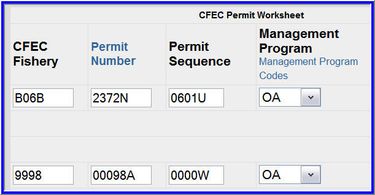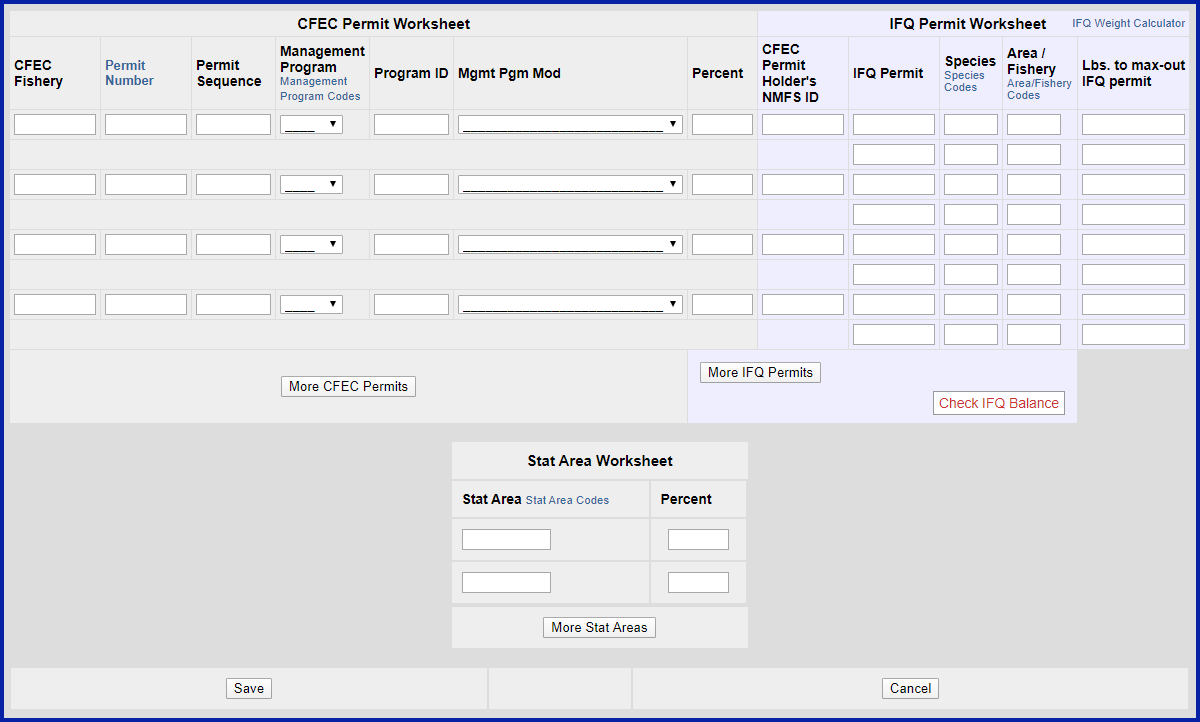...
The eLandings application contains a few new information elements that will need to be provided to successfully submit the landing report. New information elements include:
— Number of Crew, including skipper
— Number of observers on board (NMFS certified groundfish or ADF&G certified crab observers only)
— Management program for the targeted species (e.g., Community Development Quota Program - CDQ, American Fisheries Act Pollock - AFA, State Managed Pacific Cod Fishery - SMPC, Open Access - OA, etc.)
— Disposition (Use or disposition of product)
— Last Delivery of Trip (final off-load, empty hull)
The new data requirements are minimal and have resulted in improved reporting efficiency of the eLandings system.
...
In the example below, three halibut IFQ quota share fishers joined together to fish. The vessel owner sells 60% of the catch and the two IFQ share holder shareholder 'crew' sell 40% of the catch.
An example of a CFEC permit worksheet with multiple permits.
...
All data elements must be correctly entered in the eLandings application for the successful submission of a landing report. In very few cases, critical data elements may fail validation restricting the completion of the landing report. Specific fields will allow the user to enter an interim value and continue the reporting process. The interim value must be replaced within 72 hours with the valid ADF&G vessel number or the CFEC permit valid for the fishery and the year. These values are provided to aid processors when an otherwise valid CFEC permit or vessel permit number fails validation. During this time period, the user can contact the local office of ADF&G or NMFS to obtain assistance or to the correct information submitted. Interim values include:
If you have received a landing of fish that needs to be sorted prior to completing the landing report, or held in a tank for a short period of time prior to weighing, please use the general code 120 - General Flatfish** *for all unsorted flatfish and the ***Pollock code - 270*for unweighed Pollock. The eLandings application will allow youto you to select *estimated weight* in this situation. This feature will allow you to document the landing, make an initial submission of the landing report to the Interagency Server, generate a fish ticket(s), and obtain the signatures for the .PDF fish tickets. When the delivery of fish has been sorted, you can recall the landing report by the unique number and replace the general species code with specific species codes and actual weights. *Processors will be provided 72 hours to replace estimated weights and general flatfish species codes with actual species codes and weights.
...
The eLandings application allows you to record itemized catch of halibut and/or sablefish, and indicate if ice/slime was present at the point it was weighed. Only vessels that qualify for ice/slime deduction may utilize this application function. Two percent is automatically deducted when ice/slime is selected. This feature is located in the Add/Edit ItemizedCatch section of the eLandings application, under Lbs. Mod (weightmodifierweight modifier), and functions for halibut and sablefish species only.
...
You can control the display of data fields to better meet the needs of your reporting requirements and your operation. As an example,you might determine that you need to have three CFEC permit lines consistently displayed and two statistical areas. To establish a display like the one illustrated below, simply select, Number of CFEC Permit Lines = 2 and Number of Stat Area Worksheet lines = 2.
The eLandings System also allows the Administrative User to add and restrict rights to additional users within a company or operation, and to set grading/sizing/pricing defaults.
...





